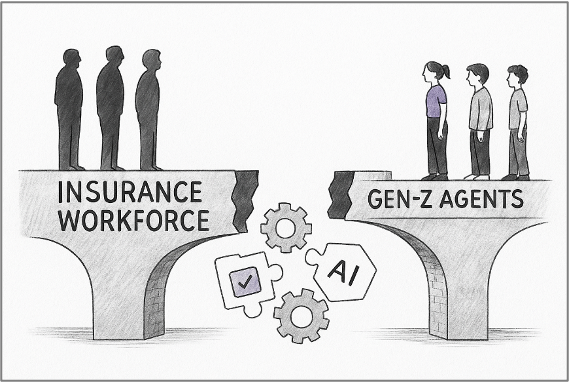InsurTech Transforming the Role of Brokers and Agents
Historically, insurance has lagged behind in terms of digital transformation, relying on labor-intensive and repetitive workflows. But as all aspects of the insurance business become more competitive and complex, insurance market participants are investing in technology solutions. From next-gen underwriting tools to automated quote-and-bind engines to AI assistants, the digitalization of insurance is picking up pace, expected to reach $150B by 2030.
Brokers and agents have long-faced operational hurdles: often, their time is inefficiently spent on manual and tedious workloads which cuts back on their ability to provide value-add work. Recognizing these challenges and the potential for tailored software solutions to solve them, the PeakSpan team has surfaced a landscape of tools that meet brokers and agents where they are. We’re excited to highlight five key areas in which Insurtech is empowering these insurance professionals’ day-to-day operations, keeping them as relevant and trusted partners as the insurance world digitalizes.

Tools for Optimizing Daily Operations
From sorting through burdensome policy documents to sitting through lengthy phone calls to conducting manual data entry, traditional broker and agent workflows incur high overhead costs and drain valuable time and resources. Solutions that collapse these processes into a streamlined, digital platform are a game changer.
Digital infrastructure that automates these historical inefficiencies and facilitates the entire insurance lifecycle keeps brokers and agents sharp, on top of their workflow, and closing deals fasterwhile also freeing up time for relationship building and client advice. By integrating AI into existing systems (e.g. underwriting tools, CRMs, policy administration) insurance providers can now conduct detailed reviews, manage multiple accounts at once, and offload repetitive tasks in a unified platform.
With these tools emphasizing performance, scalability, and flexibility, insurance professionals can innovate and scale smarter — empowered to tap into new markets.

Tools for a Superior Customer Experience
Consumers increasingly expect the same level of personalization and effortless buying experience in insurance as they do in ecommerce or any other industry. And while insurance isn’t one-size-fits-all, many policyholders are forced into rigid policies, leaving them either underinsured or paying for unnecessary coverage. At the same time, human-centered relationship building and client support is a key part of differentiating as a broker or agent. Thus, our team identifies tools that copilot insurance professionals’ customer relationships, enabling them to provide digital-first and personalized experiences while maintaining a human touch.
Similarly, policy administration and claims management processes are often slow and lacking the flexibility to meet the unique needs of individual customers. Through sales engines and user-experience tools such as CRMs that surface actionable customer insights, brokers and agents have the oversight and flexibility to tailor policies on a need-by-need basis. As a result, customers feel good about the prices they’re paying, ensuring stronger customer relationships and higher retention. Now able to scale efficiently while maintaining personalization and quality, brokers and agents have more time for what matters most: building lasting client relationships.
Tools for Specialized Coverage
Due to a lack of agility, insurance providers historically passed up providing coverage to niche or fragmented markets, inhibited by the high effort required for relatively low commissions. Take the SMB market, for example. Major insurance providers have deprioritized coverage for these businesses, considering them overly resource-intensive, with 75% of US small businesses operating with inadequate insurance, and 43% lacking coverage entirely, creating a significant protection gap.
The risks and unfamiliarity of niche markets create a costly barrier to entry which kept brokers and agents hesitant, and yet it remains critical that these underserved sectors receive appropriate coverage. By cutting down the traditional overhead costs and de-risking entry through versatile platforms that enable custom-built insurance solutions, brokers and agents become empowered to break into these under-insured spaces.
Emerging digital platforms open the doorway for more nimble solutions. Horizontal solutions that cover broad industries and product segments oftentimes struggle to provide nuanced solutions to specialty verticals, such as extreme sports coverage. Tools that reduce operational costs,provide data-driven risk analysis, and permit quick policy delivery enable the entry of verticalized solutions that understand the market from top-to-bottom, all working synergistically to close these persistent coverage gaps.
Tools for Bringing Insurance to Market
The process of marketing, finalizing, and distributing insurance policies was once time-consuming: a provider had to advertise their product, identify a customer, manually assess their risk profile, and then estimate and propose a quote. Repeating this cumbersome process for each new client slowed down the quote turnover rate and constrained the growth of a broker’s business.
Now, digital tools are available to offload this workflow and streamline distribution channels while providing targeted sales and marketing. Access to comparative pricing information, automated data entry, and CRMs enable brokers and agents to offer their clients instant service, boosting their quote-to-bind ratio while staying price-competitive.
Beyond gaining speed, brokers and agents also gain scale — the bandwidth to grow their book of business to untapped levels. Through pre-built digital interfaces built for broad-scale commercialization and distribution, insurance professionals don’t have to worry about actively managing policies, building a website of their own, or marketing their products. Instead, they can focus on expanding their business by bringing products to market faster and more widely than ever.

Tools for Closing the Talent Gap
The insurance industry has struggled to attract younger talent, resulting in a talent gap as older generations retire from the workforce. Labor forecasts predict upwards of 21,000 annual insurance job vacancies over the next industry, making it critical that the industry make changes to appeal to new talent, particularly by equipping them with modern tools. With fewer experienced industry professionals available to service demand, brokers and agents are searching for a way to do more with less manpower.
Through tech built to facilitate onboarding, coach employees, and enhance their overall productivity, getting new brokers and agents up and running has never been easier. Additionally, with the rise of these management and productivity platforms, rather than being displaced as new technology progresses, agents and brokers are able to leverage these tools to multiply their capabilities and remain adaptive and relevant as Gen-Z enters the workforce.
With more scalable operations through smart automation, brokers and agents can tap into new markets and satisfy client needs more effectively, all while remaining competitive in this quickly digitizing space. We are excited to share emerging tech within insurance distribution that that enables and empowers — rather than replaces — the broker and agent.
At PeakSpan, we are hungry to partner with innovative B2B solution providers attacking the insurtech space. We invest at the Series A/B stage, have $2BN+ in AUM, and can write $10-$30M+ checks. If you know of any scaleups attacking the issues that plague insurance, please don’t be shy and reach out to justin@peakspancapital.com!


